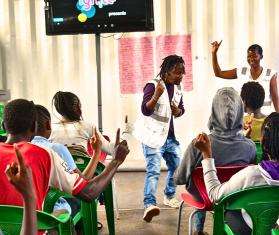Thyolo is a rural district in Malawi, a country in southern Africa which is among the 10 most affected by HIV/AIDS worldwide. Among the district’s 600,000 inhabitants, one out of five adults is living with HIV, and many are impoverished. Authorities face a dire shortage of healthcare workers. And yet, despite this bleak outlook, the Ministry of Health, together with Doctors Without Borders/Médecins Sans Frontières (MSF), not only offers access to antiretroviral treatment (ART) to those who need it, they do so at reasonable and affordable costs.
Marielle Bemelmans, MSF head of mission in Malawi, explains how this works and why the high prices of new HIV/AIDS drugs puts this great achievement in peril.
In Thyolo district, universal access to ART has become a reality. It means that at least eight out of 10 people who need ART are actually getting it – currently more than 14,000 patients. How was it achieved?
HIV/AIDS care has been integrated into the public health system and standardized as much as possible. It includes only one standard first-line regimen of drugs and simplified laboratory monitoring. Also, services have been decentralized to smaller health centers. This means that medical responsibilities are shifted from doctors to nurses and other healthcare workers. In a country with such an acute shortage of doctors, this task-shifting strategy was crucial and allowed us to increase four-fold the number of people who start ART.
What are the benefits of this approach?
A decentralized approach to public health means that people access treatment closer to their homes, and consequently spend less money and time on transportation. More people in the district now know about the services from having seen family members, friends, and colleagues get better after treatment. This motivates them to come to the clinics, get tested, and start treatment. Also, we have been able to start people on treatment long before they become ill; their CD4 cell count at treatment initiation is now at an average of 250, which indicates that the immune system still works relatively well. The waiting period between the first test and the moment when patients take their first pillhas been reduced from more than three months to three weeks on average.
This all sounds fine, but is this approach affordable for a developing country like Malawi?
At the moment, it costs €233 (US$331) to treat one patient for one year. In addition to covering the antiretroviral drugs, which take up more than half of the budget, that amount also covers other drugs, laboratory tests, staff, support services, and supervision. From the district’s perspective, the per capita financial burden for the HIV/AIDS treatment program is €2.60 (US$3.70) per inhabitant per year. In developing countries, which often spend only between €10 (US$14.20) and €20 (US$28.40) per capita on health services, it is still a significant cost. But it is doable.
What would undermine sustaining the hard-won universal access to treatment in Thyolo?
The main threat is the high prices of newer HIV/AIDS drugs. Let me explain: today, more than 95 percent of patients in Thyolo take relatively cheap generic first-line antiretroviral drugs. First of all, there is a need to introduce a more robust first-line regimen with fewer side-effects. But even if patients take their first-line drugs regularly, they will inevitably need to change to newer second-line, or even third-line drugs after a couple of years. But most of these newer drugs are patented and are not yet available as cheaper generics. As more people will need to switch to newer drugs over the coming years, the costs of this program will increase astronomically because of spiraling drug costs. The point is that we need to take all the necessary measures right now, to ensure competition between different companies producing generic drugs. This is the best way to get the newer drugs at a much cheaper rate.



